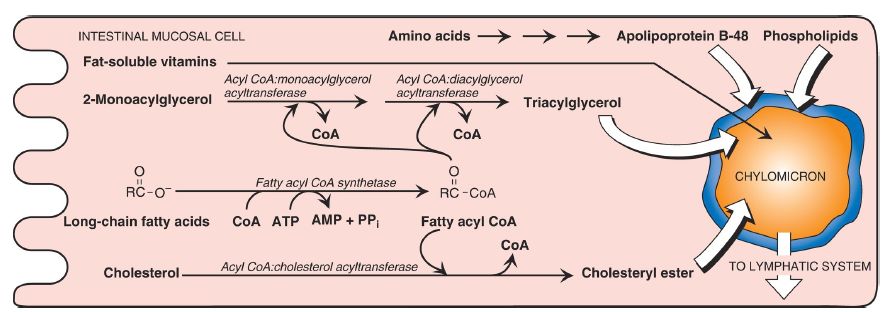


 النبات
النبات
 الحيوان
الحيوان
 الأحياء المجهرية
الأحياء المجهرية
 علم الأمراض
علم الأمراض
 التقانة الإحيائية
التقانة الإحيائية
 التقنية الحيوية المكروبية
التقنية الحيوية المكروبية
 التقنية الحياتية النانوية
التقنية الحياتية النانوية
 علم الأجنة
علم الأجنة
 الأحياء الجزيئي
الأحياء الجزيئي
 علم وظائف الأعضاء
علم وظائف الأعضاء
 الغدد
الغدد
 المضادات الحيوية
المضادات الحيوية|
Read More
Date: 24-9-2021
Date: 7-11-2021
Date: 29-8-2021
|
Lipid Secretion from Enterocytes
The newly resynthesized TAG and cholesteryl esters are very hydrophobic and aggregate in an aqueous environment. Therefore, they must be packaged as particles of lipid droplets surrounded by a thin layer composed of phospholipids, nonesterified cholesterol, and a molecule of the protein apolipoprotein (apo) B-48 . This layer stabilizes the particle and increases its solubility, thereby preventing multiple particles from coalescing. [Note: Microsomal triglyceride transfer protein is essential for the assembly of all TAG-rich apo B–containing particles in the ER .]
The lipoprotein particles are released by exocytosis from enterocytes into the lacteals (lymphatic vessels in the villi of the small intestine). The presence of these particles in the lymph after a lipid-rich meal gives it a milky appearance. This lymph is called chyle (as opposed to chyme, the name given to the semifluid mass of partially digested food that passes from the stomach to the duodenum), and the particles are named chylomicrons.
Chylomicrons follow the lymphatic system to the thoracic duct and are then conveyed to the left subclavian vein, where they enter the blood. The steps in the production of chylomicrons are summarized in Figure 1. [Note: Once released into blood, the nascent (immature) chylomicrons pick up apolipoproteins E and C-II from high-density lipoproteins and mature. (For a more detailed description of chylomicron structure and metabolism.)]
 Figure 1: Assembly and secretion of chylomicrons by intestinal mucosal cells. [Note: Short- and medium-chain-length fatty acids do not require incorporation into chylomicrons and directly enter into the blood.] CoA = coenzyme A; AMP = adenosine monophosphate; PPi = pyrophosphate.
Figure 1: Assembly and secretion of chylomicrons by intestinal mucosal cells. [Note: Short- and medium-chain-length fatty acids do not require incorporation into chylomicrons and directly enter into the blood.] CoA = coenzyme A; AMP = adenosine monophosphate; PPi = pyrophosphate.



|
|
|
|
دراسة يابانية لتقليل مخاطر أمراض المواليد منخفضي الوزن
|
|
|
|
|
|
|
اكتشاف أكبر مرجان في العالم قبالة سواحل جزر سليمان
|
|
|
|
|
|
|
المجمع العلمي ينظّم ندوة حوارية حول مفهوم العولمة الرقمية في بابل
|
|
|